Dijon, France
Dijon is the capital city of the historical Burgundy region in
eastern France, one of the country’s principal wine-producing areas.
Famous for mustard and gingerbread, Dijon is also the gateway to the
most prestigious Burgundy vineyards. Indeed, the reputation of the
route of the ‘Grands Crus’ has earned it the epithet the ‘Champs
Elysees of Burgundy.’ Discover the magnifient landscapes with vines as
far as the eye can see and even a chateau right at the heart of the
Côte de Nuits vineyard.
Paris, the national capital, is located 160 miles northwest of Dijon, while Talant is 2 miles to the northwest.
There’s more to Dijon than mustard. About ninety minutes by the
high-speed TGV rail service from Gare de Lyon, Paris’s little sister is
just as chic as the capital, without the big-city vibe. Rue de la
Liberte is Dijon’s Champs-Elysees shopping street, there’s a mini Arc
de Triomphe, there’s even a bike rental scheme called Velodi, a kissing
cousin of the original Parisian version, Velib.
The Duchy of Burgundy was led by four successive dukes: Philip the
Bold, John the Fearless, Philip the Good and Charles the Bold. Philip
the Good, who ruled from 1419 to 1467, had a major influence on Dijon;
he captured Joan of Arc and turned her over to the English. He also
made Burgundy a leading centre for the arts and rebuilt the duchal
palace (Palais des Ducs, off Place de la Liberation). You can climb the
316 stairs to the 46-metre tower he added for views of colourful tiled
rooftops (a trademark of Burgundy), crooked mediaeval streets, monastic
buildings and, beyond the city, vineyards, forests and villages. Since
1799, the palace has been a fine arts museum, Musee des Beaux-Arts. One
of the oldest and most beautiful museums in France.
Plan and Book:



Dijon: See and Do
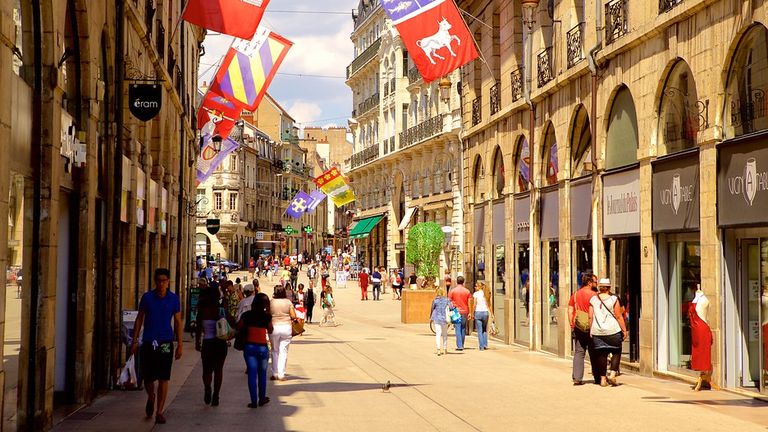
Sit at a table extending out from one of the cafés and
restaurants around Liberation Square and watch people strolling past.
Have French wines, main dishes enhanced with sauces made with local
Dijon mustard and pain d’epices gingerbread. After your meal, relax
with a book on a bench and savor the atmosphere in this typically
French square as you sip a kir drink of white wine and creme de cassis.
Learn about local and exotic plant species at the Arquebuse Gardens.
Make sure you bring your camera so you can snap a few photos of the
most striking specimens.
For some outdoor time, head on over to the area’s much-loved green
spaces. Darcy Square and the Suzon Japanese Garden Park are lovely
places to get lost in a great book. Port du Canal Park is another nice
option.
The Museum of Sacred Art and the Magnin Museum offer a range of
collections that are bound to spark your curiosity. You might also want
to consider a visit to the La Vie Bourguignonne Museum and the Museum
of Fine Arts.
The preserved specimens at the Musée Archeologique provide a fascinating glimpse into exotic, unknown worlds.
Take a look at what’s happening at the Musee Rude or the Musée
des Beaux-Arts and see if there’s anything that catches your interest.
If you’re lucky, you might even be able to catch an exhibition opening!
To find out more about the area’s rich and colorful past, make sure you
visit its many historic structures and monuments. Start the local
history tour at the University of Burgundy or the Hotel Aubriot. More
tales from a bygone era are waiting for you at Tour de Bar and the
Maison Maillard. Once the private dwelling of the area’s wealthiest,
today the doors to these most stately homes are open to everyone. If
you can find one, a guided tour will help you get the most out of your
visit to Palace of the Dukes and Palace of the Dukes of Burgundy.
Whether you’re a spiritual person or not, you’ll be sure to enjoy a
trip to Church of Notre Dame and Dijon Cathedral. You could also
explore Paroisse Saint Michel de Dijon or Cathedrale St-Benigne.
Great public squares provide a space for the inhabitants of a city to
gather and enjoy the fresh air. A tour of the area would be incomplete
if you didn’t go through either Liberation Square or Place Emile Zola.
Take a moment to stop by the Maison Milliere, Tour Philippe le Bon and
Saint-Philibert Church and discover the influential experiences and
events that helped make Dijon what it is today.
La Toison d’Or Shopping Center is a bustling retail zone, filled with interesting fashion, accessories and grocery shops.
Zenith Dijon and Dijon Congrexpo are popular performing arts venues
that are frequented by visitors and artistically minded locals alike.
Traveling golfers can always enjoy a few rounds at the Golf Club Jacques Laffite Dijon Bourgogne and the Golf de la Chassagne.
Highlights
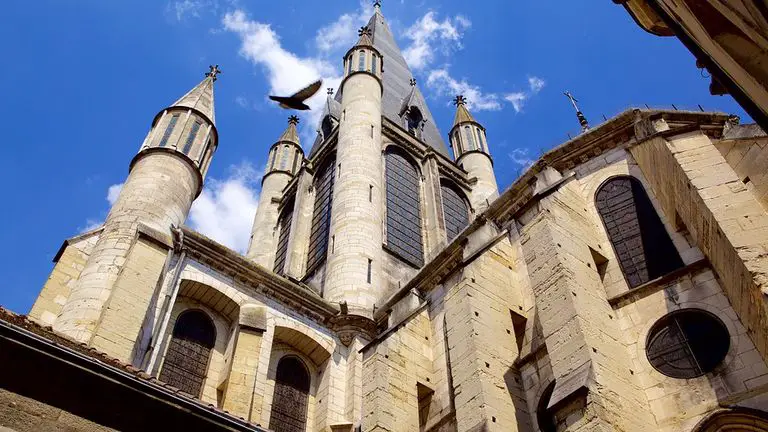
Church of Notre-Dame
The Church of Notre-Dame, with its eering gargoyles and the
mechanical clock, is the iconic epicenter of Dijon. With its narrow
pillars and grand arches, the 13th-century Gothic structure haunts a
square in the heart of the city. Work commenced on the church in about
1230. The Church of Notre-Dame is in the center of Dijon’s old
town on a plaza of the same name and just north of the Square des Ducs.
See the famous statue of Notre Dame de Bon Espoir at this Gothic
masterpiece. Enter the spacious nave and make your way to the statue of
Notre-Dame de Bon-Espoir, a wooden statue that dates back to the 11th
century. It is among the oldest Virgin statues in the country. Its baby
Jesus disappeared during the French Revolution and the Madonna’s hands
are missing. Due to its historical importance, it is one of the most
intriguing artifacts in the church. Admire the five stained-glass
windows in the northern transept. They have survived from the 1200s and
tell the stories of St. Peter and St. Andrew. A 19th-century artist
used the original panes as inspiration for more than 50 new
stained-glass windows.
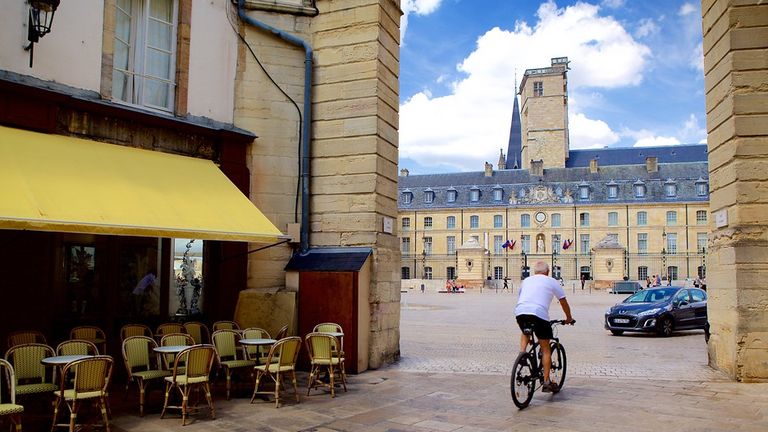
Liberation Square
Liberation Square is a stunning semicircular plaza in the heart of
Dijon’s historic center. It is home to glorious fountains,
statues and important buildings that date back many centuries. Walk
through the large pedestrianized square to appreciate its open feel and
majestic structures. Stand in front of the 14th-century Palace of the
Dukes of Burgundy and admire its classical design. Here you’ll
find the town hall and the Museum of Fine Arts. Learn about the
structure’s regal history and the family that once resided here.
Look around the museum, which opened in 1787. Its enormous collection
includes fascinating items from Egyptian art to 21st-century pieces.
Liberation Square is just south of the Church of Notre-Dame in the old
town area of Dijon. The Magnin Museum, the Square des Ducs and many
shops and restaurants surround the plaza. Take a bus or easily walk to
the square from many of the sites in the city’s centre.
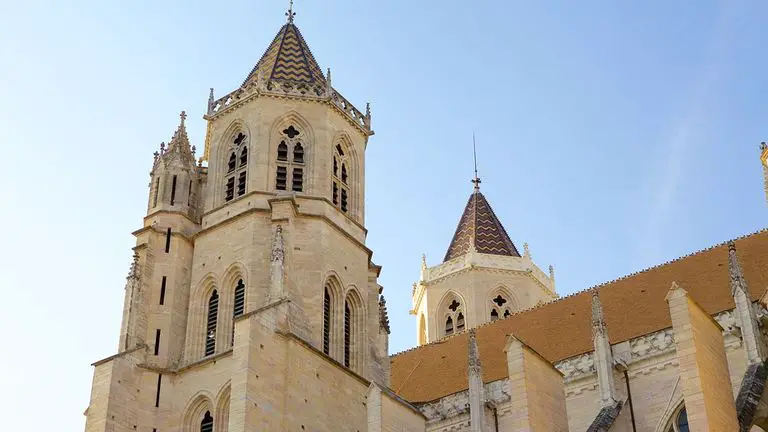
Dijon Cathedral
Dijon Cathedral is an early 14th-century Gothic church known for its
fascinating museum and tall columns and spires. Its twin towers present
one of the most recognizable icons of the city, making it a French
national monument. Enjoy the eeriness of this old giant, from its
gargoyles outside to the subterranean tomb inside. The church serves as
a museum as well as a place of worship. Peruse the intriguing relics
from the Middle Ages as well as fascinating Roman artifacts. Descend
the steps to the crypt to see the sarcophagus of Saint-Benigne. Note
the Romanesque decor of the tomb. Dijon Cathedral is less than a
10-minute walk west from the Square des Ducs in the center of the city.
It stands next to the St. Philibert Church, the Theatre Dijon Bourgogne
– Parvis Saint-Jean and the Théâtre des Feuillants. Take a
bus to the center of the city or walk from the nearby attractions to
reach the cathedral.
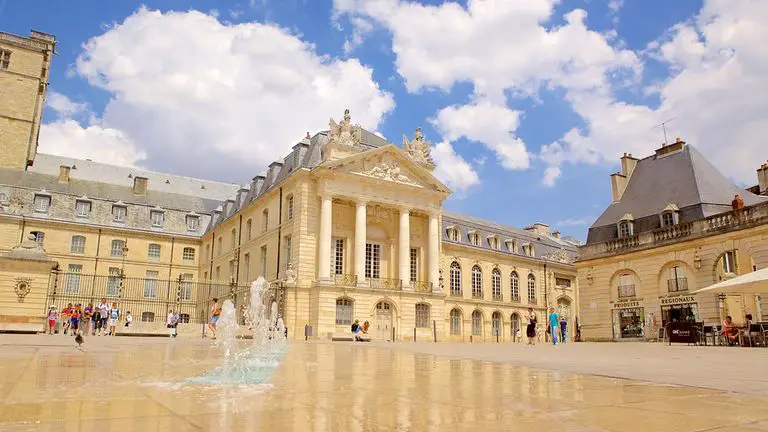
Palace of the Dukes
The Palace of the Dukes is a major highlight of Dijon’s
historic center. It is a fascinating stately structure with a rich
history entwined with royalty, tombs and politics. Now, it is home to a
museum of fine arts that displays a wide selection of artistic works as
well as a comprehensive history of the palace. Several other dukes with
intriguing nicknames occupied the residence over the next century,
including John the Fearless and Philip the Good. Tombs of several of
the dukes lie in the palace. Marvel at their gold casing and protective
angel sculptures. The Palace of the Dukes is located in Liberation
Square in the heart of Dijon.
Surrounding Area

Mont Blanc
The roof of Western Europe, rising to 4,810m, Mont Blanc is the
world’s third most-visited natural sight. The Massif du
Mont-Blanc’s unique setting enables it to offer a huge choice of
outdoor activities , ranging from mountaineering, off-piste skiing and
climbing to hiking, either along its mountain trails or glaciers.
A climb to the summit requires excellent physical fitness, to help you
endure the 10-12 hours of strenuous effort required at these high
altitudes, as well as the services of a professional mountain guide.
Some mountain guiding companies also offer the option of an
exhilarating and unforgettable descent on skis from the summit.
Training is offered prior to your ascent.
It is also possible to admire Mont Blanc from the Pic du Midi,
accessible in just 20min via the Aiguille du Midi cable-car , which
climbs an impressive 2,700m from Chamonix to an altitude of 3,842m. At
this altitude, you’ll discover a formidable view of Mont Blanc
from one of the four panoramic terraces accessible to visitors.
Design by W3layouts
